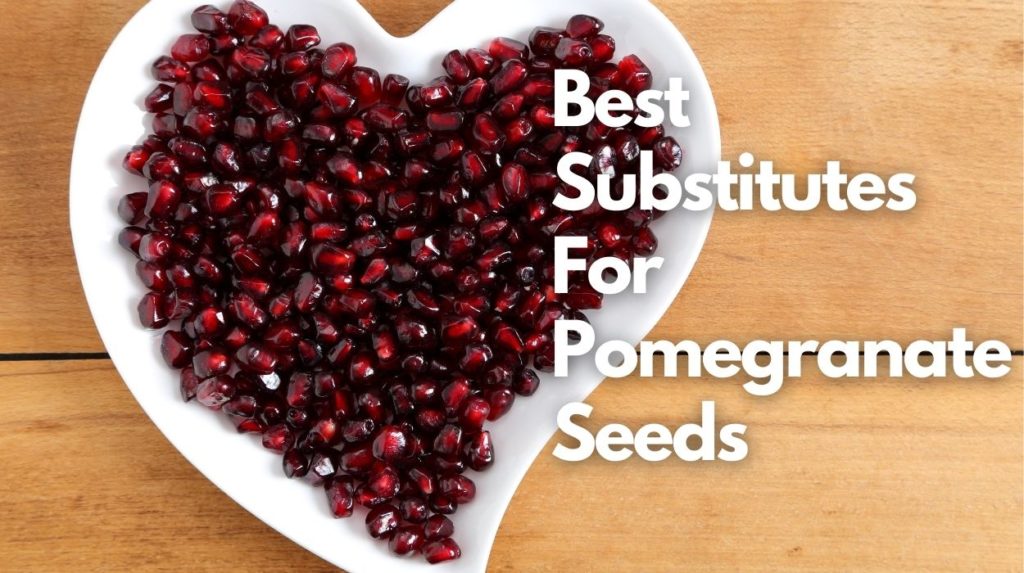
Are you trying to jazz up your salad with nutritious and delicious pomegranate seeds? Or, are you stepping up your breakfast game with oatmeal sprinkled with pomegranate seeds? These superfoods are a reliable option when it comes to bringing a pop of color and a dose of nutrition to any dish.
But running out of pomegranate seeds can alter your plans for getting and eating healthy. But don’t worry; you can try its alternatives like raspberries, cranberries, dried apricots, raisins, and many more.
The following article will explore more such substitutes for pomegranate seeds. So, let us get started!
Best Substitutes for Pomegranate Seeds
Along with the substitutes, the following article will also explain when and how to use them in place of pomegranate seeds.
1. Raspberries

Raspberries come from the Rosaceae family. It is a fruit covering the core with tiny beads, also known as drupelets, each containing one seed. On average, one raspberry contains 100-120 seeds.
The word “raspberry” is derived from “raspise,” which means “sweet rose-colored wine.” The meaning is quite synonymous with its taste since you get a blend of sweetness with an undertone of tartness.
Its floral notes of it will help you make delicious smoothies and juices.
Even though there are red, black, gold, and purple varieties of raspberry, we’d suggest going with the red one, given you want something similar to pomegranate seeds.
Look for ripe raspberries since they are the sweetest and most intense in terms of taste.
You can add them to smoothies, oatmeal, salads, or make yogurt parfaits and muffins. If not, you can also enjoy them straight from the garden or the packet while soaking in the sun on a warm sunny day.
2. Cranberries

Like pomegranate seeds, cranberries are small and round red fruits that are also a close cousin of blueberries.
Cranberries are also regarded as a superfood due to their immensely high nutritional value. They contain antioxidants that help protect against liver diseases. Moreover, this fruit is said to improve eyesight and heart health.
But cranberries are not as sweet as pomegranate seeds. Instead, they have an invigorating tart taste, something that will remind you of lemons. Their tart taste is due to their low sugar content.
Nevertheless, you can add them to your stir-fry salad or oatmeal for an irresistible flavor. If you want some sweetness to your dessert, you must add sugar to it.
Lastly, Thanksgiving is incomplete without cranberry sauce. You can make it at home rather than buying it from the supermarket.
Apart from that, you can add it to prepare apple pies, sorbets, or smoothies.
In case you are only able to find dried cranberries, you can add them to warm water for 10 minutes. This will make the cranberries juicy and plump again.
3. Dried Apricots
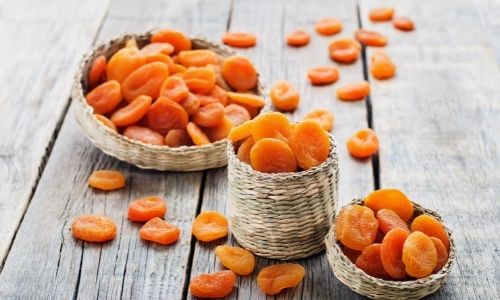
Dried apricots are traditionally dried fruit that is treated with sulfur dioxide. Due to such treatment, they have a dark and vivid orange color. If you find dried apricots with lighter colors, it signifies the lower sulfur dioxide content.
Apart from being delicious, dried apricots are a potent source of potassium, vitamin A, and antioxidants. Such a composition helps improve digestion and lower cholesterol.
Not only are they low in calories, but they are basically free from fat. This will help you binge eat it without worrying about gaining weight.
Their taste varies in the range of sweet and bitter. They might also come off as sour, along with the freshness of their fresh fruit.
You can eat them as an evening snack or add them to your smoothie or fruit salad, just like pomegranate seeds. You can also dip it in cheese to make a side dish if you are up for experimentation.
4. Blackberries

Blackberries and raspberries have the same texture with color differences. Similar to raspberries, blackberries have a white core with one-seeded droplets surrounding them.
Even though blackberries and raspberries are botanically-related, they are different fruits with varying growing seasons.
The taste of blackberries depends on their ripening range. For example, if you eat unripe blackberries, they will taste bitter. However, you can enjoy its sweetness by picking out ripe blackberries.
Nutritionally, blackberries contain Vitamin C, K, manganese, and fiber that fasten the wound healing process. Moreover, it enhances oral and brain health.
You can try eating them raw. Either you can devour the whole fruit along with the seed or simply eat the part that surrounds it.
If not, you can add it to salads, cereals, yogurt, or make a jam out of it for a healthy and delicious breakfast.
5. Red Currants
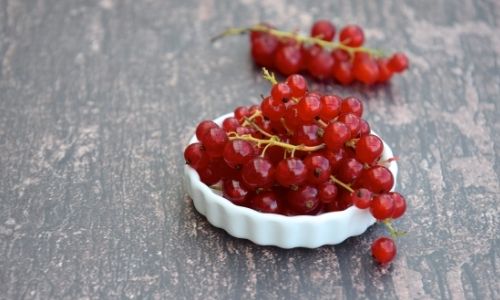
Red currants are small and round fruits with translucent skin. They have gem-like berries that grow low on bushes.
Similar to raspberries, red currants can be eaten raw due to their sweet and sour flavor. However, if you find them tart, you can sprinkle some sugar on them to enjoy their taste.
Apart from the taste, red currants have a high nutritional value. For starters, they have a lower glycemic index value which helps prevent sugar cravings, mood swings, and sugar crashes. Moreover, it helps fight infections and improves the condition of your hair and skin.
You can add them to jams, sauces, and baked goods. Aside from sweet dishes, you can also add them to savory dishes like a lamb in the form of a sauce.
6. Figs

Figs might not have that vibrant red color of pomegranate seeds, but its taste makes up for the deviation in terms of looks.
A fig is a soft and sweet fruit-filled with several seeds. You can eat it as soon as it ripens. Or, you can also eat it dry.
A ripe fig is quite tender. It tastes like honey with hints of tartness, but it does not get overwhelming.
Apart from the taste, figs are rich in nutrition. They contain antioxidants and fiber that promote better digestive health. Furthermore, they help improve bone health, maintain blood pressure, and facilitate weight management.
Like the alternatives mentioned earlier, you can consume them raw. You can consume it entirely or peel the skin off. But always, always cut off the stem before eating the fig.
You can add it to your breakfast cereal, oatmeal, or smoothies. It also works well with a fruit salad containing other fruits like apples, oranges, peach, and blackberries.
7. Raisins

Grapes are ever-giving fruits. Not only can you enjoy them when they are ripe, but they also leave their dried offspring as delicious dry fruit.
Raisins are nothing but dried grapes. The drying process includes the concentration of sugars and nutrients present in the grapes. This makes them high in nutrition but also high in calories.
You can find different types of raisins like golden-yellow, brown, and red. While the golden-yellow raisins are added to cakes and muffins, the red and brown ones are consumed as a snack.
When eaten in moderation, you can benefit from raisins due to their high amount of antioxidants. They also contain calcium and iron that improve heart and bone health.
Since they are sweet, you can easily substitute pomegranate seeds with raisins in oatmeal, cereal, or a salad.
8. Sour Cherries
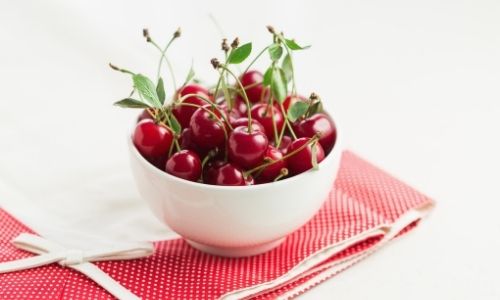
The mixture of tartness and sweetness of sour cherries makes them a reliable substitute for pomegranate seeds.
As evident from the name, sour cherries are tart. As compared to sweet cherries, they are smaller and softer. Nevertheless, this makes it easier to add to jams and pies.
Since they have high acid content with low sugar, the tannic flavor mixed with undertones of sweetness will certainly make you reminisce about pomegranate seeds.
As they are filled with Vitamin C and antioxidants, daily consumption of sour cherries improves heart health and reduces inflammation and chances of cancer.
You can either eat them raw or use them to make sauces. Some people believe that they complement well with cheese as well.
9. Dates

Dates might not be everybody’s first option, but it is a healthy alternative to pomegranate seeds.
Dates are soft with a fibrous texture. They are larger than pomegranate seeds and are generally reddish-brown in color.
Regardless, the sweetness makes it easier to add flavor to any pomegranate dish.
In terms of the health aspects, dates help with weight loss, bone health, and immunity.
You can consume them as a snack due to their high moisture level. If not, you can add them to oatmeal, smoothie, or yogurt. Once you add dates, you’ll not be required to add additional sugar.
10. Pomegranate Syrup
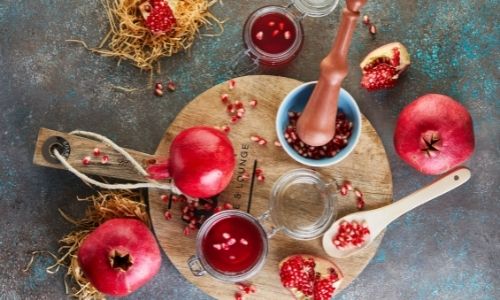
If the texture of pomegranate seeds is not of utmost importance to you, you can also try pomegranate syrup. You’ll easily find it online or at your nearest supermarket.
There are several ways to use pomegranate syrup. For example, try adding sparkling water to prepare a refreshing beverage. Or, you can use it to make iced tea.
You can also sprinkle some syrup into your salad dressing to get that sweet-sour taste of pomegranate.
Easiest Way to Remove Pomegranate Seeds
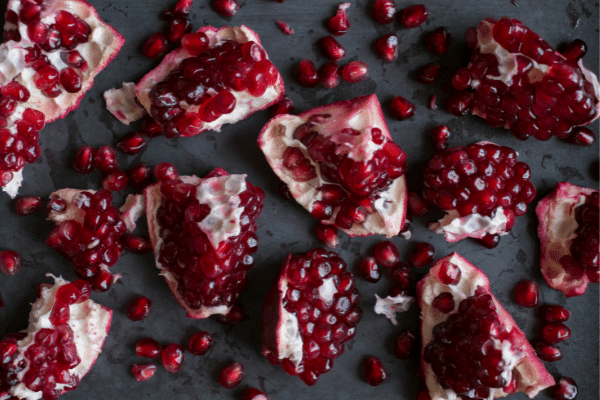
One of the main reasons why people are always looking for alternatives to pomegranate seeds is the mess that follows while trying to extract the seeds.
But what if we told you there is an easy hack to remove pomegranate seeds without abrupting your kitchen counter successfully?
Follow these steps:
- Start by washing the pomegranate to remove the bacteria from the outer surface.
- Take a sharp knife and cut it horizontally.
- Hold the pomegranate with the cut side facing down over a medium-sized bowl.
- Using a wooden spoon or spatula, wack firmly on the top surface of the pomegranate. Don’t just give a light wack. Try to be as solid and hard as possible.
- Continue the process till all the seeds have fallen into the bowl.
- Repeat the same with the other half.
Storing Pomegranate Seeds
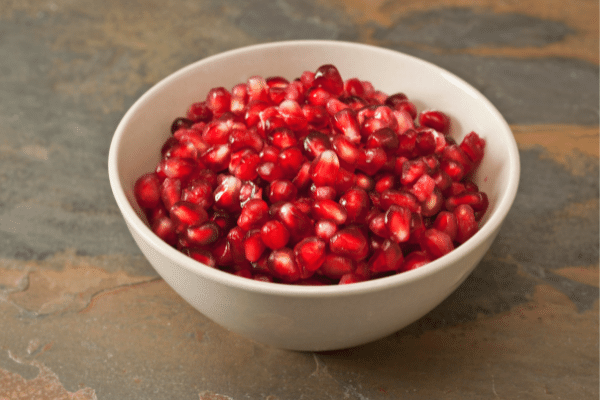
Once you have victoriously removed the seeds, you eat them or add them to your recipes. If not, you must transfer them to an airtight container or a zip-lock bag and refrigerate them. This should help you use them for the next 4-5 days.
You can also freeze them by laying the seeds on a sheet pan covered with waxed or parchment paper. Pop them in the freezer for 2 hours. Once they are frozen, transfer them to an airtight container or a ziplock bag. Doing so will help you preserve your pomegranate seeds for 2-3 months.
FAQs
Can you buy fresh pomegranate seeds?
If scooping out the pomegranate seeds is not viable for you, you can easily find fresh pomegranate seeds in the supermarket’s produce section. They are available across the United States round of the year.
Do you have to wash pomegranate seeds before eating them?
Washing the pomegranate fruit is important to remove the bacteria. However, the choice is yours whether you’d like to wash the pomegranate seeds before eating them or not.
If you want to remain extra careful, transfer the seeds into a bowl and rinse them under cold running water. This will remove any additional bacteria.
Do you have to refrigerate pomegranate seeds?
Yes, you must refrigerate pomegranate seeds to preserve them. You can place them in an airtight container or bag to maintain their quality. You can also freeze and preserve them for several months.
Final Note
Pomegranate seeds excel not only in terms of taste but also in their nutritional value. These delicious and sweet fruits contain vitamins, minerals, fiber, and protein, with few calories and fat.
Nonetheless, the substitutes like raspberries, cranberries, and dates mentioned above do not lag as well when it comes to nutrition and taste.
So, which one will you be going for, and why? Let us know in the comments below!



